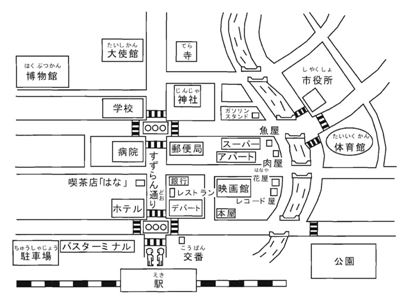Two tourists are standing in front of the train station and are beginning a day of sightseeing. Look at the map and complete the dialogue. Put a particle inside the parentheses, and put a phrase/sentence/word in each of the blanks.
A: ????????????? (1._______ ) ?????????????
B: ??????????????(2._______ ) ?????????
A: ??????(3.) _______________________ (supposed to be waiting)???????
B: ??????????(4.) _____________ (if he hasn't arrived yet)????????????
After the phone call.
B: ?(???)???(5.) ________________ (after parking the car)????????
A: ?(???)????(6.) ______________ (if walking)???????????? (7.) _______________ (supposed to be visible)???????????????
B: ???????????????????????
A: (8.) ____________ (if it's an old place)??????????
B: ?????????? (9.________ ) (10.) _____________ (go straight on Suzuran Street)??????
A: ?????????(??)? (11.) ______________ (after eating)????????

1.?
2. ?
3.???????
4. ??????????
5.???????
6. ???????
7. ?????
8.???????
9. ?
10. ??????
11.?????
You might also like to view...
Complete lo siguiente, usando por o para.
Compré los libros ______________ Anabel. Pagué doscientos dólares ______________ los libros. ______________suerte tenía mi tarjeta de crédito.
Come sono i posti di Gino e Corrado?
Ascoltate il dialogo e poi rispondete alle domande con una frase completa. (Listen to the dialogue, then answer the questions with a complete sentence.)
One brand of dog food uses the slogan "Love them like family. Feed them like family" and begins the ad by looking at the list of ingredient in other dog foods compared to brand X. Brand X wants you to feed your dog with food that is similar to the food you feed your family. What is the hidden assumption?
a. Dogs have the same nutritional needs as people. b. Dogs are as important as people. c. If you don't give your dog this kind of dog food, you don't love your animal enough. d. People who love their families feed them good food.
Decide whether the topic listed for the paragraph is too broad, too narrow, or the correct topic for the paragraph. Choose the letter of the correct answer.
Emergency medical services in many cities have begun advising 911 callers to give a person who has collapsed chest compressions but not mouth-to-mouth resuscitation.1 In emergencies, lives are generally saved or lost in the first six minutes, so trying to explain mouth-to-mouth procedures to callers was wasting precious time and doing more harm than good. In addition, new research suggests that mouth-to-mouth resuscitation is not effective in the first few minutes after a collapse. Therefore, emergency medical dispatchers are explaining to untrained callers only how to perform chest compressions to mimic2 a steady heartbeat until paramedics can arrive. Adapted from Robert Davis, “Simpler Method for CPR Adopted,” USA Today, February 24, 2004, 1A. Main Idea: a. Many emergency medical services dispatchers are no longer explaining to callers how to give a victim mouth-to-mouth resuscitation. b. Emergency medical services are advising people not to try to save someone who has collapsed. c. Mouth-to-mouth resuscitation is very difficult to perform properly. d. Research has shown that mouth-to-mouth resuscitation does more harm than good.